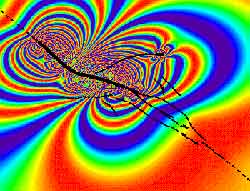Forecasting the Next Great San Francisco Earthquake

In this computer graphic from Rundle’s research, colored fringes represent ground movement around faults. (UC Davis Computational Science and Engineering Center/graphic)
The San Francisco Bay region has a 25 percent chance of a magnitude 7 or greater earthquake in the next 20 years, and a roughly 1 percent chance of such an earthquake each year, according to the “Virtual California” computer simulation.
The Virtual California approach to earthquake forecasting is similar to the computer models used for weather forecasting, said John Rundle, director of the UC Davis Computational Science and Engineering Center, who has developed the model with colleagues from the Jet Propulsion Laboratory and other institutions. A previous forecast of earthquake hazards, the Working Group on California Earthquake Probabilities, used records of past earthquakes to calculate the probability of future ones.
The Virtual California model includes 650 segments representing the major fault systems in California, including the San Andreas fault responsible for the 1906 San Francisco earthquake. The simulation takes into account the gradual movement of faults and how they interact with each other.
The researchers used the model to simulate 40,000 years of earthquakes in California. They found almost 400 major (magnitude 7 or above) earthquakes at an average interval of 101 years. The simulation data indicates a 25 percent chance of another such earthquake in the next 20 years, a 50 percent chance in the next 45 years and a 75 percent chance by 2086.
The latest work is published in Proceedings of the National Academy of Sciences of the USA. Other authors on the paper are Paul Rundle, Donald Turcotte, Robert Scherbakov and Gleb Yakovlev at UC Davis; Andrea Donellan, Peggy Li and Jay Parker, Jet Propulsion Laboratory; Bruce Malamud, King’s College, London; Lisa Grant, UC Irvine; Geoffrey Fox, Indiana University, Bloomington; Dennis McLeod, University of Southern California; Bill Klein, Boston University; and Kristy Tiampo, University of Western Ontario, Canada.
Media Contact
More Information:
http://www.ucdavis.eduAll latest news from the category: Earth Sciences
Earth Sciences (also referred to as Geosciences), which deals with basic issues surrounding our planet, plays a vital role in the area of energy and raw materials supply.
Earth Sciences comprises subjects such as geology, geography, geological informatics, paleontology, mineralogy, petrography, crystallography, geophysics, geodesy, glaciology, cartography, photogrammetry, meteorology and seismology, early-warning systems, earthquake research and polar research.
Newest articles

Silicon Carbide Innovation Alliance to drive industrial-scale semiconductor work
Known for its ability to withstand extreme environments and high voltages, silicon carbide (SiC) is a semiconducting material made up of silicon and carbon atoms arranged into crystals that is…

New SPECT/CT technique shows impressive biomarker identification
…offers increased access for prostate cancer patients. A novel SPECT/CT acquisition method can accurately detect radiopharmaceutical biodistribution in a convenient manner for prostate cancer patients, opening the door for more…

How 3D printers can give robots a soft touch
Soft skin coverings and touch sensors have emerged as a promising feature for robots that are both safer and more intuitive for human interaction, but they are expensive and difficult…




















